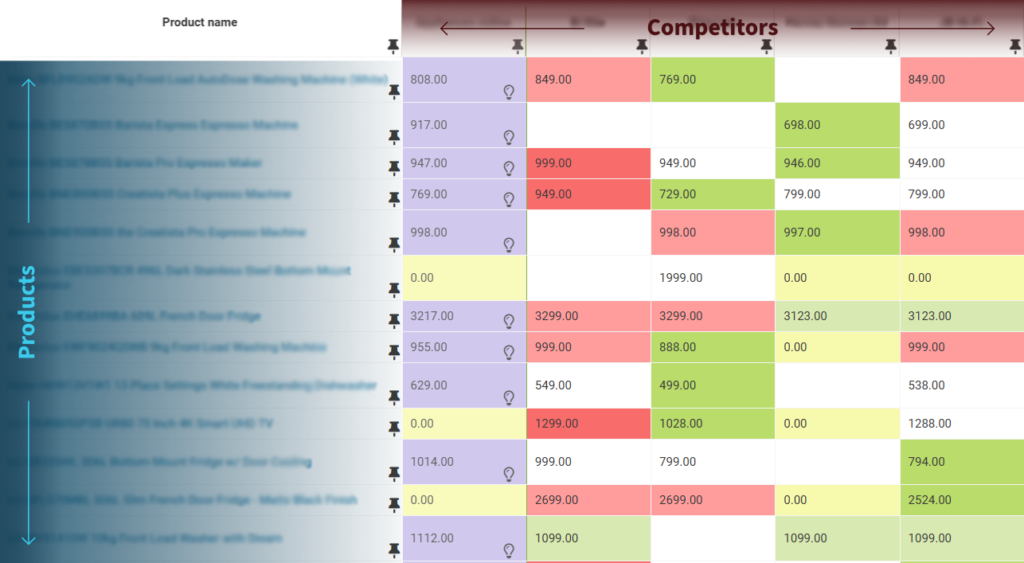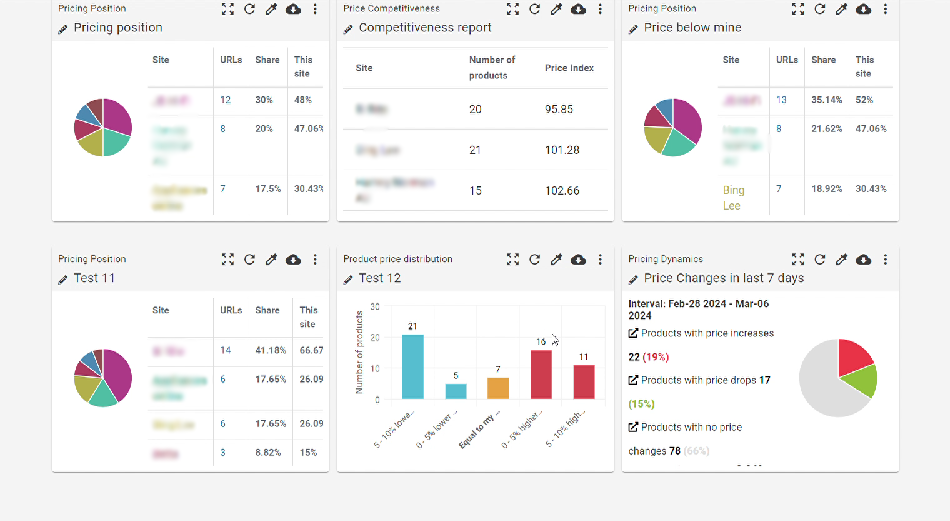
Product Price Comparison – a Definitive Guide for eCommerce Professionals
Product price comparison has become a necessity for almost every online retailer. On one hand, it is very likely that your competitors are already checking your prices. On the other hand, customers are and have been checking prices diligently for quite some time.
Product price comparison allows online retailers to:
- gain deeper insights into the competition and their pricing strategies,
- anticipate market changes (both in terms of general trends and shifts in demand), and
- better understand current and potential customers and tailor their own pricing strategies to align with them.
In this product price comparison guide for online retailers we will tell you:
- What does price comparison mean in eCommerce?
- How to compare prices of your competitors?
- What to do with those insights?
- What are the benefits of online price comparison?
Let’s get started!
What is product price comparison in eCommerce?
Price comparison in eCommerce is a method of comparing prices of identical or similar products sold by your competitors. It can also include your own prices, for better price benchmarking.
It is frequently visually represented as a matrix. One axis (usually the horizontal one) represents competitors, and the vertical axis represents products. Each cell in the matrix has the price of a certain product from a particular competitor.

Product price comparison in eCommerce – key steps
The key steps to performing price comparison in eCommerce are:
- Match products: Find equivalent products on competitor websites
- Track prices: Note down competitors’ prices (in the smallest time interval as possible)
- Depending on the industry, this process can be more or less frequent. For example, the musical industry has multiple daily price changes. On the other hand, industries such as … have a lower frequency of price changes.
- Product price comparison: Performing the product price comparison itself
- Advanced analysis (optional)
Match products: Find equivalent competitor products for price comparison
This step takes time. The good thing however, is that it doesn’t require frequent revisions (with an exception, but we will come to that).
When done manually, product matching usually looks something like this:
- Create a new spreadsheet. You will likely have some of the following columns: Competitor name, Product name, Product URL, and Price.
- List your own products first, with their current prices.
- Look for each competitor’s product you want to compare prices with. Copy the URL, and paste into the spreadsheet.
You are now ready for the next step.
Before we continue, about that exception. Sometimes, competitors can change their URL slugs, URL structure (folders), or even the whole domain. In this case, a revision is required. You will know this is the case when you visit the market URL again and encounter an error.
If there’s no error, but you still may not see the price, the product may be out of stock.
Track prices: Noting down competitor product prices
You visit a competitor’s website. Then you find the relevant product. You note down the price and you go on to the next product, until you are finished with that website.
That’s the essence of manual price tracking.
One caveat here is that things can get complicated if there are parameters on the product page. Or in other words, if there are multiple products on the same URL. For example, if you are competing with dog food sellers, you may have to note down the prices of each taste + size combination.
Depending on the scale you are doing this on, it can take a while. This is why many eCommerce professionals opt for tools that automate the price tracking process. These tools save time overall, as the technology behind them makes it possible to crawl prices of competitor products in a matter of minutes.
Furthermore, quicker price checks don’t only free up the slots in your calendar. They also reduce the time-window in which the complete price monitoring process is finalized.
This means that, as opposed to manual price monitoring, there’s no risk of the first-checked prices becoming outdated when you finish the last ones.
Product price comparison: Performing the price comparison itself
Now that you have all the prices for all the competitors’ products noted down, it’s time to compare them.
The basic product price comparison in eCommerce gives the following insights:
- What competitor has the highest price for a certain product?
- What competitor has the lowest price for a certain product?
- What competitor(s) doesn’t have a certain product in stock?
- What competitor has the highest overall prices?
- What competitor has the lowest overall prices?
- Are there any outliers in terms of prices for certain products?
Besides all of that, you may also sort & filter your data in different ways. You can also calculate means, modes, averages, and standard deviations for each product or seller to better understand them.
Additionally, you may also be able to notice trends and patterns for competitors and products. For example: discounts before holidays, price increases when availability is limited, etc.

Free 14-day trial!
Start your Price2Spy trial now, and see how it can ease the process of implementing your pricing strategy.
Try for freeAdvanced analysis
If you want to go beyond the basics with product price comparison, here’s what you can try:
- Price elasticity of demand (PED) – the formula for calculating PED is PED=%ΔQuantity demanded/%ΔPrice. This formula, however, requires you to have a quantifiable value for changes in the demand levels or sales. This is difficult to obtain. What you can do instead is track competitor price changes over time and notice any market share shifts. This will give you a rough estimate of the elasticity.
- Price leadership/followship – these concepts represent two sides of the same coin. Price leadership is the behavior of setting pricing trends on the market. Price followship, on the other hand, refers to the reactionary type of behavior, where one follows the price dynamics after they have been set in motion. When comparing product prices over time, you will easily be able to distinguish between competitors and see what type of behavior they gravitate towards.
- Market share estimation – here, the emphasis is on ‘estimation’. If you notice that a certain competitor has lower prices consistently for all or a majority of their products, they may be attracting more price-sensitive customers. This may be a sign of two things: 1) market penetration pricing strategy, or 2) that particular competitor may have a high market share in categories where price sensitivity is high.
- Cluster competitors based on their pricing strategies – there are multiple approaches here. You can define price bands (cheap, mid, expensive) for each product category. Additionally, you may cluster competitors on their pricing consistency. This clustering can range from ‘stable’ to ‘volatile’, for example. Competitors with fewer price changes and with a more predictable pricing behavior would be clustered in the ‘stable’ segment. On the other hand, competitors with more dynamic prices would fall into the ‘volatile’ category.
The benefits of performing product price comparison
The general benefits of product price comparison are:
- Learn competitors’ pricing strategies and habits – by monitoring competitor prices, you can understand their pricing structure, discounts, and promotional strategies. This allows you to adapt your own pricing tactics to stay competitive.
- Discover competitor inventory levels – product price comparison can reveal whether competitors are running out of stock or offering overstocked products, providing valuable insights into their sales strategies and potential gaps in the market you can capitalize on.
- Gain competitive advantage – product price comparison provides a snapshot of the competitive landscape, helping you identify where you can outperform competitors.
The benefits of automating product price comparison
In addition to the general benefits above, we would like to point out benefits of automating this process (as opposed to doing it manually):
- Save time – free up yourself and your team from tedious manual price-checks.
- Up-to-date data – automated systems can check prices at the interval you specify, serving you with the fresh pricing data when you need it.
- Intuitive overview – automated tools provide easy-to-understand dashboards and reports, allowing you to assess pricing trends at a glance.
- Scalability – as your business grows, manually tracking prices for hundreds or thousands of products becomes increasingly impractical.
Conclusion
As you have seen, when talking about product price comparison in eCommerce, there are two ways you can go about it. You can do it either manually or automate it.
Manual product price comparison may seem cheaper at first. This may be true for small-scale eCommerce businesses.
However, the calculation changes when we increase the scale of operations. The more products and competitors you are dealing with, the more sense it makes to switch to an automated price comparison tool.
Also, if you want to use advanced analysis methods (either the ones mentioned above, or different ones), automated product price comparison is the way to go.
Both approaches have similar steps, you just need to decide which one is the right for you and your business.




